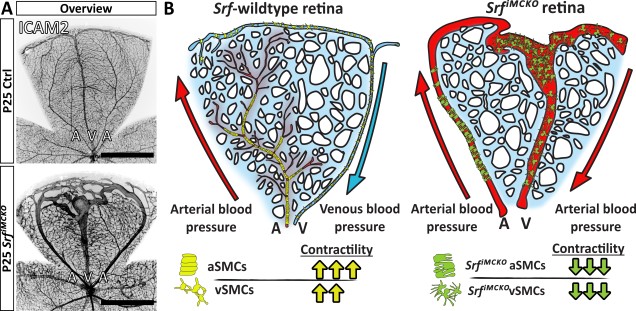The role of mural cells in vascular malformations
We are studying to what degree non-endothelial cells contribute to the formation of vascular malformations and are currently focusing on mural cells in this context. Mural cells are perivascular cells that are tightly associated with blood vessels. Depending on their location and molecular properties we distinguish two types of mural cells: vascular smooth muscle cells (vSMCs), which are associated with the bigger caliber vessels, arteries, arterioles, veins and venules and pericytes (PC), which cover capillaries, the smallest diameter blood vessels. Mural cells are essential for vascular integrity, and their loss has been associated with numerous diseases, yet little is known about their role in vascular malformations.
We have recently generated a mouse model that allows us to delete the Serum Response Transcription Factor (SRF) in mural cells and found that its deletion causes the formation of arterio-venous malformations in retinal blood vessels (Fig 1A). SRF positively regulates the expression of smooth muscle genes and by deleting SRF, the smooth muscle cells lose their ability to contract and to maintain the vascular tone. This has severe consequences since the affected blood vessels cannot regulate blood flow any longer which results in reduced oxygenation and long-term tissue damage. In an attempt to normalize blood flow some branches remodel into arteriovenous shunts that funnel a proportion of the blood directly to the venous circulation (Fig.1B).
For our research we primarily use advanced imaging techniques like confocal microscopy and single/multiphoton intravital microscopy to study the vasculature in detail.

- Wissenschaftlicher Arbeitsgruppenleiter
